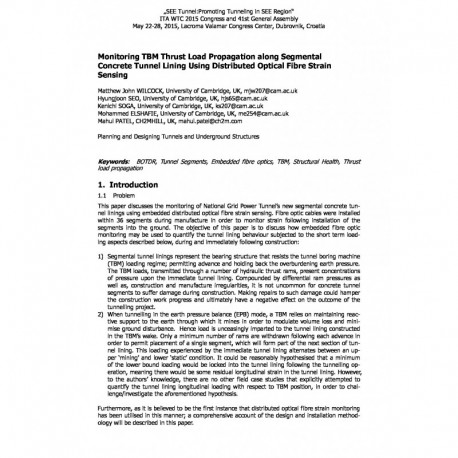Cart
0
0
No document
0,00 €
Total
Document successfully added to your shopping cart
Quantity
Total
There are 0 items in your cart.
There is 1 item in your cart.
Total documents
Total shipping
To be determined
Total
Search & filter
Search for a publication
Search & filter
Monitoring TBM Thrust Load Propagation along Segmental Concrete Tunnel Lining Using Distributed Optical Fibre Strain Sensing
wtc2015_full_wilcock
M. J. Wilcock / H. Seo / K. Soga / M. Elshafie / M. Patel
1.1Problem This paper discusses the monitoring of National Grid Power Tunnel’s new segmental concrete tun-nel linings using embedded distributed optical fibre strain sensing. Fibre optic cables were installed within 36 segments during manufacture in order to monitor strain following installation of the segments into the ground. The objective of this paper is to discuss how embedded fibre optic monitoring may be used to quantify the tunnel lining behaviour subjected to the short term load-ing aspects described below, during and immediately following construction: 1)Segmental tunnel linings represent the bearing structure that resists the tunnel boring machine (TBM) loading regime; permitting advance and holding back the overburdening earth pressure. The TBM loads, transmitted through a number of hydraulic thrust rams, present concentrations of pressure upon the immediate tunnel lining. Compounded by differential ram pressures as well as, construction and manufacture irregularities, it is not uncommon for concrete tunnel segments to suffer damage during construction. Making repairs to such damage could hamper the construction work progress and ultimately have a negative effect on the outcome of the tunnelling project. 2)When tunnelling in the earth pressure balance (EPB) mode, a TBM relies on maintaining reac-tive support to the earth through which it mines in order to modulate volume loss and mini-mise ground disturbance. Hence load is unceasingly imparted to the tunnel lining constructed in the TBM’s wake. Only a minimum number of rams are withdrawn following each advance in order to permit placement of a single segment, which will form part of the next section of tun-nel lining. This loading experienced by the immediate tunnel lining alternates between an up-per ‘mining’ and lower ‘static’ condition. It could be reasonably hypothesised that a minimum of the lower bound loading would be locked into the tunnel lining following the tunnelling op-eration, meaning there would be some residual longitudinal strain in the tunnel lining. However, to the authors’ knowledge, there are no other field case studies that explicitly attempted to quantify the tunnel lining longitudinal loading with respect to TBM position, in order to chal-lenge/investigate the aforementioned hypothesis. Furthermore, as it is believed to be the first instance that distributed optical fibre strain monitoring has been utilised in this manner; a comprehensive account of the design and installation method-ology will be described in this paper.




